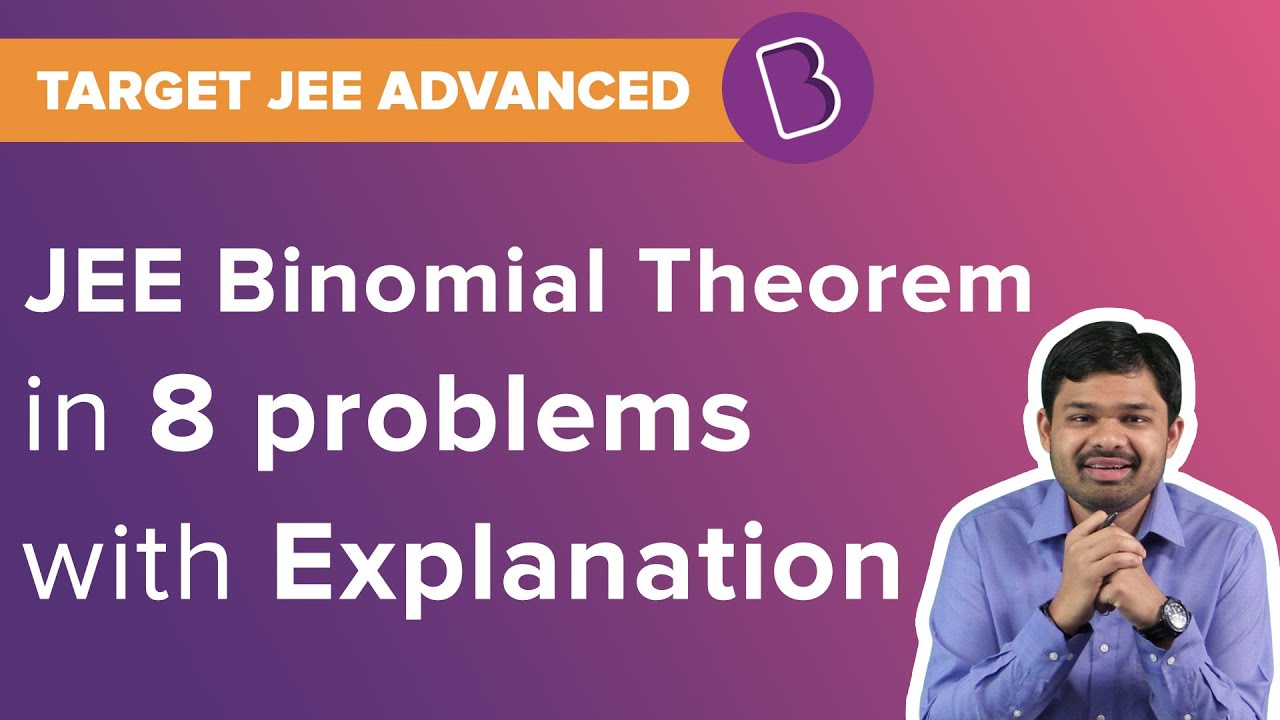Binomial Theorem and Mathematical Induction are two important concepts in JEE preparation. In algebra, the Binomial Theorem focuses on the expansion of powers on any binomial expression. The Binomial theorem describes the algebraic expansion of powers of a binomial whereas Mathematical Induction is a technique which is used to prove a mathematical formula, a statement or a theorem is true for all the natural numbers. This mathematical technique basically includes three steps to prove a statement. This article covers the Binomial theorem, the formula for the general term in binomial expansion, the formula for the middle term in binomial expansion and the Binomial formula of some expansions. The Binomial Theorem and Mathematical Induction questions from the previous years of JEE Main are present on this page, along with the detailed solution for each question. These questions include all the important topics and formulae. About 1-2 questions are asked from this chapter in the examination every time.
Download Binomial Theorem and Mathematical Induction Previous Year Solved Questions PDF
Binomial Theorem and Mathematical Induction Previous Year Questions with Solutions
Question 1: If (1 + ax)n = 1 + 8x + 24x2 +…., then the value of a and n are ________.
Solution:
As given (1 + ax)n = 1 + 8x + 24x2 +….
On comparing same coefficients, we have
⇒ na (n − 1) a = 48
8 (8 − a) = 48
8 − a = 6
⇒ a = 2
⇒ n = 4
Question 2: If the coefficient of x7 in (ax2 + [1/bx])11 is equal to the coefficient of x−7 in (ax − 1/bx2)11, then ab = __________.
Solution:
In the expansion of (ax2 + [1/bx])11, the general term is
Tr + 1 = 11Cr (ax2)11 − r (1/bx)r
= 11Cr * a11 − r * [ 1/br ] * x22 − 3r
For x7, we must have 22 – 3r = 7
r = 5, and the coefficient of x7 = 11C5 * a11−5 * [1/b5] = 11C5 * a6 * b5
Similarly, in the expansion of (ax−1bx2)11, the general term is
Tr + 1 = 11Cr * (−1)r * [a11 − r/br ] * x11 − 3r
For x-7 we must have, 11 – 3r = -7 , r = 6, and the coefficient of x−7 is 11C6 * [a5/b6] = 11C5 * a5 * b6.
As given, 11C5 [a6/b5] = 11C5 * [a5/b6]
⇒ ab = 1
Question 3: Find the value of

Solution:
(1 − x)30 = 30C0x0 − 30C1x1 + 30C2x2 + . . . . . . + (−1)30 30C30x30 ….(i)
(x + 1)30 = 30C0 x30 + 30C1x29 + 30C2x28 + . . . . . . + 30C10x20 + . . . . + 30C30x0 ….(ii)
Multiplying (i) and (ii) and equating the coefficient of x20 on both sides, we get
required sum = coefficient of x20 in (1 – x2)30 = 30C10.
Question 4: If
Solution:
Neglecting higher powers of x, then
Question 5: In the polynomial (x − 1) (x − 2) (x − 3) . . . . . (x − 100), what is the coefficient of x99?
Solution:
(x − 1) (x − 2) (x − 3) . . . . . (x − 100)
Number of terms = 100
Coefficient of x99 = (x − 1) (x − 2) (x − 3) . . . . . (x − 100)
= (−1 −2 −3 −. . . . . . −100)
= − (1 + 2 + . . . . . +100)
= − [100 * 101 / 2
= – 5050
Question 6: In the expansion of (x + a)n, the sum of odd terms is P and sum of even terms is Q, then the value of (P2 − Q2) will be _________.
Solution:
(x + a)n = xn + nC1xn−1 a + . . . . . = (xn + nC2xn−2a2 + . . . . . . . + (nC1xn−1a + nC3xn−3a3 + . . . . .) = P+Q
(x − a)n = P − Q
As the terms are altered,
P2 − Q2 = (P + Q) (P − Q) = (x + a)n (x − a)n
P2 − Q2 = (x2 − a2)n
Question 7: If the sum of the coefficients in the expansion of (1 − 3x + 10x2)n is a and if the sum of the coefficients in the expansion of (1 +x2)n is b, then what is the relation between a and b?
Solution:
We have a = sum of the coefficient in the expansion of (1 − 3x + 10x2)n = (1 − 3 + 10)n = (8)n
(1 − 3x + 10x2)n = (2)3n, [Putting x = 1] .
Now, b = sum of the coefficients in the expansion of (1 + x2)n = (1 + 1)n = 2n.
Clearly, a = b3
Question 8: (1 + x)n − nx − 1 is divisible by (where n∈N)
A) 2x
B) x2
C) 2x3
D) All of these
Solution:
(1 + x)n = 1 + nx + ([n (n − 1)] / [2!]) * x2 + ([n (n − 1) (n − 2)] / [3!]) * x3 + . . . . .
(1 + x)n − nx − 1 = x2 [([n (n − 1)] / [2!]) + ([n (n − 1) (n − 3)] / [3!]) * x + . . . . .]
From above it is clear that (1 + x)n − nx − 1 is divisible by x2.
Trick: (1 + x)n − nx − 1, put n = 2 and x = 3;
Then 42 − 2 * 3 − 1 = 9 is not divisible by 6, 54 but divisible by 9, which is given by option (b) i.e., x2 = 9.
Question 9: If the three consecutive coefficients in the expansion of (1 + x)n are 28, 56 and 70, then the value of n is ______.
Solution:
Let the three consecutive coefficients be nCr−1 = 28, nCr = 56 and nCr+1 = 70, so that
nCr / nCr−1 = [n − r + 1] / [r] = 56 / 28 = 2 and nCr+1 / nCr = [n − r] / [r + 1] = 70 / 56 = 5 / 4
This gives n + 1 = 3r and 4n − 5 = 9r
4n − 5 / n + 1 = 3
⇒ n = 8
Question 10: Let R = (5√5 + 11)2n + 1 and f = R − [R], where [.] denotes the greatest integer function. The value of R * f is
Solution:
Since (5√5 − 11) (5√5 + 11) = 4
5√5 − 11 = 4 / (5√5 + 11), Because 0 < 5√5 − 11 < 1 ⇒ 0 < (5√5 − 11)2n + 1 < 1, for positive integral n.
Again, (5√5 + 11)2n + 1 − (5√5 − 11)2n + 1 = 2 {2n+1C1 (5√5)2n * 11 + 2n + 1C3(5√5)2n − 2 × 113 + . . .. +
2n + 1C2n+1 112n+1}
= 2 {2n+1C1(125)n * 11 + 2n+1C3(125)n−1 113 +. . . . . . + 2n+1C2n+1 112n+1}
= 2k, (for some positive integer k)
Let f′= (5√5 − 11)2n + 1 , then [R] + f − f′=2k
f − f′ = 2k − [R]
⇒ f − f′ is an integer.
But, 0 ≤ f < 1; 0 < f′<1
⇒ −1 < f − f′ < 1
f − f′ = 0 (integer)
f = f′
Therefore, Rf = Rf′ = (5√5 + 11)2n + 1 * (5√5 − 11)2n + 1
= ([5√5]2 + 112)2n + 1
= 42n+1
Question 11: The digit in the unit place of the number (183!) + 3183 is _____.
Solution:
We know that n! terminates in 0 for n³ at 5 and 34n terminator in 1, (because 34 = 81)
Therefore, 3180 = (34)45 terminates in 1.
Also 33 = 27 terminates in 7
3183 = 3180 * 33 terminates in 7.
183! + 3183 terminates in 7 i.e. the digit in the unit place = 7.
Question 12: If the coefficients of pth, (p + 1)th and (p + 2)th terms in the expansion of (1 + x )n are in A.P., then find the equation in terms of n.
Solution:
Coefficient of pth, (p + 1)th and (p + 2)th terms in expansion of (1 + x )n are nCp−1, nCp ,nCp+1. Then 2nCp = nCp−1 + nCp+1
⇒n2 − n (4p + 1) + 4p2 − 2 = 0
Trick: Let p = 1, hence nC0, nC1 and nC2 are in A.P.
⇒ 2 * nC1 = nC0 + nC2
⇒ 2n = 1 + [n (n − 1)] / [2]
⇒ 4n = 2 + n2 − n
⇒ n2 − 5n + 2 = 0
Question 13: The interval in which x must lie so that the greatest term in the expansion of (1 + x)2n has the greatest coefficient, is _____.
Solution:
Here the greatest coefficient is 2nCn.
Therefore, 2nCnxn > 2nCn+1xn−1 ⇒ x > n / [n + 1] and 2nCnxn > 2nCn-1xn+1
⇒ x < [n + 1] / n
Hence, the required interval is (n / [n + 1], [n + 1] / n).
Question 14: The approximate value of (1.0002) 3000 is __________.
Solution:
(1.0002) 3000 = (1 + 0.0002) 3000
= 1 + (3000) (0.0002) + ([(3000) (2999)] / [1.2]) * (0.0002)2
= 1 + (3000) (0.0002)
= 1.6
Question 15: The last digit in 7300 is __________.
Solution:
We have 72 = 49 = 50 − 1
Now, 7300 = (72)150
= (50 − 1)150
= 150C0 (50)150 (−1)0 + 150C1 (50)149 (−1)1 + . . . . . .+ 150C150 (50)0 (−1)150
Thus, the last digits of 7300 are 150C150 * 1 * 1 i.e., 1.
Video Lessons
Binomial theorem – Solved Questions

Binomial Theorem – Important Topics


Comments